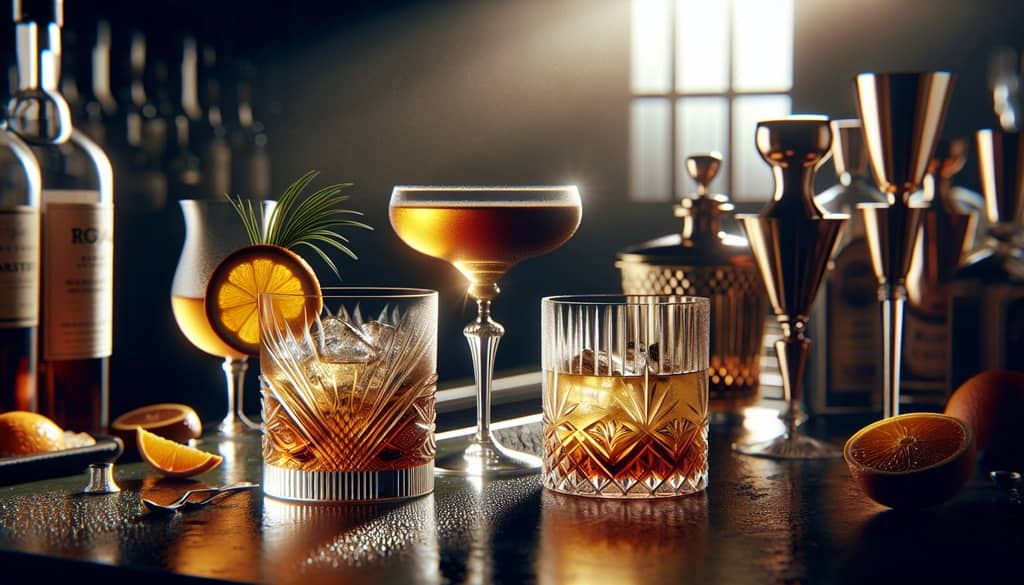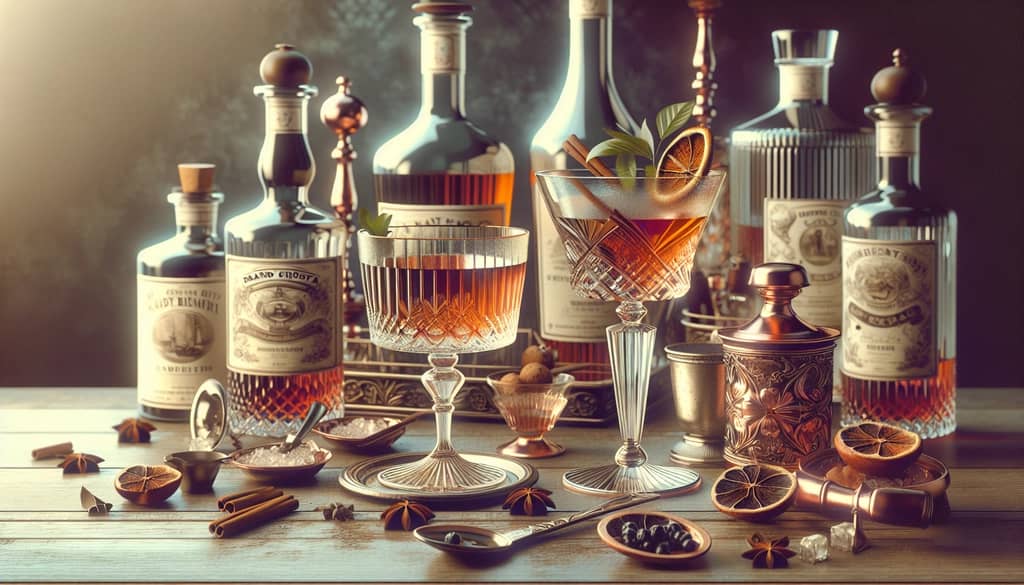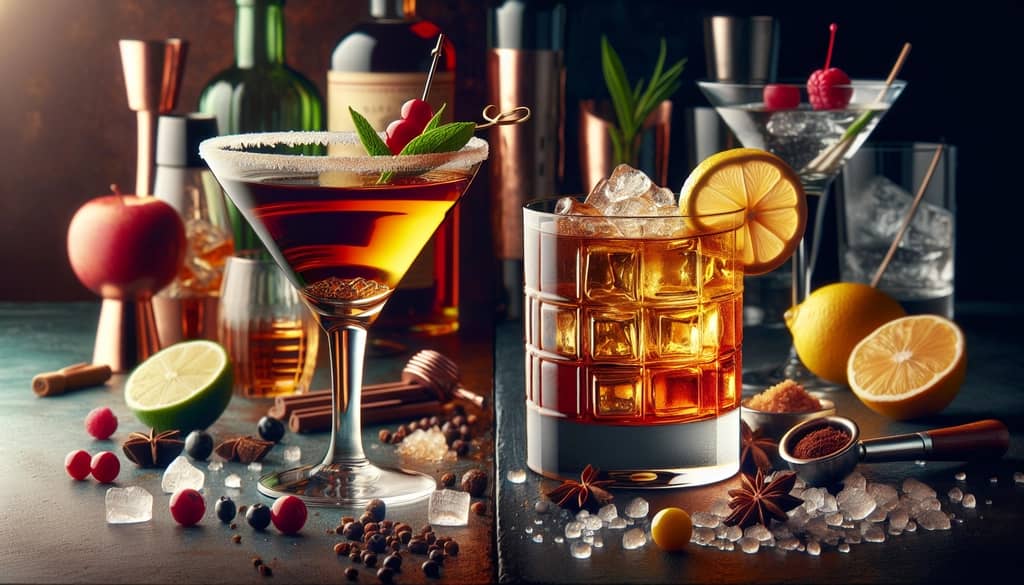Updated on: 6/3/2025
Comparing Classics: Brandy Crusta vs. Sidecar

Introduction
In the world of cocktails, there are timeless classics that have stood the test of time. Among these, the Brandy Crusta and the Sidecar are two iconic drinks that have captured the hearts of cocktail enthusiasts around the globe. Despite their shared foundation of brandy, these two cocktails offer distinct experiences, both in flavor and in preparation. In this article, we'll delve into the nuances that set the Brandy Crusta apart from the Sidecar and explore why these differences matter to cocktail aficionados.
Fast Facts
- Main Ingredients: Both cocktails prominently feature brandy, but additional ingredients vary—such as lemon juice, triple sec, and sugar for the Sidecar, and maraschino liqueur, bitters, and orange peel for the Brandy Crusta.
- Origin: The Brandy Crusta dates back to the mid-19th century in New Orleans, while the Sidecar emerged during the 1920s, often associated with Paris.
- Glassware and Presentation: The Brandy Crusta is known for its distinctive garnish and presentation in a crusted glass, whereas the Sidecar is typically served in a simple, sugared-rim cocktail glass.
- Flavor Profile: The Brandy Crusta offers a complex and slightly bitter profile due to the bitters and maraschino liqueur, in contrast to the Sidecar’s balanced sour and sweet notes.
- Popularity: Both cocktails have experienced revivals, but the Sidecar remains more prevalent in modern cocktail menus.
History and Origins

The Brandy Crusta
The Brandy Crusta hails from the vibrant city of New Orleans in the mid-1800s and is credited to Joseph Santini, a bartender known for his creative flair. This cocktail revolutionized the way drinks were served by incorporating citrus juice in a way that wasn't common before. Its hallmark is the crusted rim of fine sugar, designed to add an extra layer of sweetness and texture.
The Sidecar
The Sidecar, on the other hand, has roots in the early 20th century. It is often linked to the post-World War I era in Paris, with several bars claiming the creation. The drink is said to have been named after a motorcycle sidecar, fitting for its era of invention. The Sidecar became a symbol of sophistication and continues to be a beloved choice at cocktail lounges worldwide.
Ingredients and Preparation
Brandy Crusta
The Brandy Crusta’s ingredients include brandy, maraschino liqueur, bitters, lemon juice, and a hint of orange liqueur. A unique aspect of its preparation is the sugar-crusted rim and a long spiral of lemon peel that adorns the inside of the glass. This elaborate presentation not only enhances the aesthetic appeal but also influences the initial flavor impressions as the cocktail is sipped.
- Combine brandy, maraschino liqueur, orange liqueur, bitters, and lemon juice.
- After thoroughly shaking with ice, strain the mixture into a sugar-rimmed glass.
- Complete the presentation with a long lemon peel inside the glass, offering a bittersweet complement to the drink.
Sidecar
The ingredients for a Sidecar typically include brandy, triple sec or another orange liqueur, and fresh lemon juice. This combination achieved a delightful balance of sour and sweet flavors that makes it highly approachable.
- Shake brandy, triple sec, and lemon juice with ice until well-chilled.
- Strain into a chilled glass, usually rimmed with sugar for an added touch of sweetness.
- A twist of lemon may be added as garnish, complementing the citrus notes.
Flavor Profiles

Brandy Crusta
The Brandy Crusta presents a rich tapestry of flavors. The combination of brandy and maraschino liqueur adds depth and complexity, while the bitters offer a unique, sophisticated bitterness. The sugared rim and the lemon juice create a sweet-sour interplay that makes each sip a sensory exploration.
Sidecar
Conversely, the Sidecar is known for its harmonious blend of tart and sweet. The fresh lemon juice provides a refreshing tartness that pairs well with the smooth, subtle sweetness of the orange liqueur and the depth of the brandy. The result is a well-rounded, effortlessly drinkable cocktail that has won global acclaim.
Popularity and Cultural Impact
The Brandy Crusta may not be as widely featured on menus today as it was in its heyday, yet it remains a favorite among cocktail connoisseurs who appreciate historical drinks and intricate craftsmanship. The Sidecar, however, remains one of the most ordered cocktails in the world, celebrated for its simple yet elegant profile.
For lovers of classic cocktails, both the Brandy Crusta and the Sidecar offer a unique taste of history. Whether you prefer the elaborate presentation and complex flavors of the Brandy Crusta or the balanced simplicity of the Sidecar, both cocktails capture the essence of their respective eras.
Call to Action
If you’re a cocktail enthusiast looking to expand your palate, try making these classics at home. The Brandy Crusta and Sidecar not only allow you to appreciate the art of mixology but also transport you to a different time, savoring the stories each sip tells.